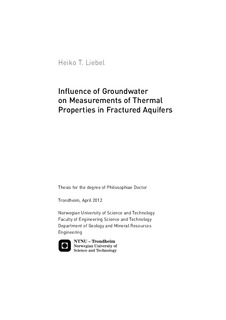| dc.contributor.author | Liebel, Heiko T. | nb_NO |
| dc.date.accessioned | 2014-12-19T11:55:07Z | |
| dc.date.available | 2014-12-19T11:55:07Z | |
| dc.date.created | 2012-08-15 | nb_NO |
| dc.date.issued | 2012 | nb_NO |
| dc.identifier | 544580 | nb_NO |
| dc.identifier.isbn | 978-82-471-3505-1 (printed ver.) | nb_NO |
| dc.identifier.isbn | 978-82-471-3507-5 (electronic ver.) | nb_NO |
| dc.identifier.uri | http://hdl.handle.net/11250/236006 | |
| dc.description.abstract | Shallow boreholes equipped with borehole heat exchangers (BHE) connected to ground-coupled heat pumps are used for the heating and cooling of buildings. Accurate estimates of ground properties are essential to properly dimension a ground-coupled heat pump system. For small projects, the ground properties are assumed for different rock types. In large projects, thermal response tests (TRT) are carried out to estimate the actual properties.
Convection and groundwater flow affect the TRT results and the operation of a ground-coupled heat pump system. This thesis investigates the influence of groundwater on measurements of thermal properties such as effective (in situ) thermal conductivity (λeff) and borehole resistance (Rb) in fractured aquifers.
A statistical analysis for selected rock types shows that λeff is in general higher than rock thermal conductivities measured from rock cores (λrock). Databases of λeff and λrock, hydraulic yield of wells, and driller’s well protocols from the Oslo region are used to test if λeff can be predicted. It is shown that λeff cannot be predicted accurately: Heterogeneities in rock mineral content, rock types along a borehole, regional groundwater flow and convection due to different heat input rates during TRTs are too large. It is documented that a high thermal conductivity is not necessarily linked to a high quartz content, but rather to the orientation of insulating layers of low conductive materials. Thermal conductivity estimates based on λrock from mapped bedrock types can give only a vague indication about the thermal conductivity one may find at a site.
The influence of groundwater on λeff was investigated in a field experiment. Two TRTs were carried out in the same borehole: A first standard TRT and a second TRT with artificially induced groundwater flow. Temperature profiles after both TRTs showed groundwater flow in a few fractures only. The measured λeff was higher for the case of groundwater flow. The influence of groundwater flow cannot be discovered from the measured λeff itself if the flow is restricted to limited areas of the borehole. But temperature profiles taken a few hours after a finished TRT allow a proper interpretation of the TRT results.
A multi-injection-rate TRT (MIR-TRT) showed that the measured thermal properties changed with increasing heat input rate. The required borehole length for a ground-coupled heat pump system would be reduced as buoyancy-driven convection increases in the borehole. A second MIR-TRT was carried out with a groundwater pump installed at the base of the same borehole. Groundwater was pumped up to the surface and re-infiltrated into the borehole. The estimate for required borehole lengths was reduced by 9 to 25 % in comparison to the preceding MIR-TRT. Consequently, artificial convection may be used to reduce the required borehole length of a ground-coupled heat pump system. | nb_NO |
| dc.language | eng | nb_NO |
| dc.publisher | Norges teknisk-naturvitenskapelige universitet, Fakultet for ingeniørvitenskap og teknologi, Institutt for geologi og bergteknikk | nb_NO |
| dc.relation.ispartofseries | Doktoravhandlinger ved NTNU, 1503-8181; 2012:113 | nb_NO |
| dc.relation.haspart | Liebel, Heiko; Huber, K.; Frengstad, Bjørn Syvert; Ramstad, Randi kalskin; Brattli, Bjørge. Rock Core Samples Cannot Replace Thermal Response Tests - A Statistical Comparison Based On Thermal Conductivity Data From The Oslo Region (Norway). Renewable Energy Research Conference 2010 - Zero Emission Buildings: 145-154, 2010. | nb_NO |
| dc.relation.haspart | Liebel, Heiko Tobias; Huber, Kilian; Ramstad, Randi kalskin; Brattli, Bjørge; Frengstad, Bjørn. Can rock core thermal conductivity data replace thermal response tests?. Proceedings of Water and Energy Conference 2010, 2010. | nb_NO |
| dc.relation.haspart | Liebel, Heiko; de Beer, Johannes; Frengstad, Bjørn; Kalskin Ramstad, Randi; Brattli, Bjørge. Effect of water yield and rock thermal conductivities on TRT results. Comunicações Geológicas. (ISSN 0873-948X). 99(1): 43-47, 2012. | nb_NO |
| dc.relation.haspart | Liebel, Heiko T.; Stolen, Marie S.; Frengstad, Bjorn S.; Ramstad, Randi K.; Brattli, Bjorge. Insights into the reliability of different thermal conductivity measurement techniques. Bulletin of Engineering Geology and the Environment. (ISSN 1435-9529). 71(2): 235-243, 2012. <a href='http://dx.doi.org/10.1007/s10064-011-0394-3'>10.1007/s10064-011-0394-3</a>. | nb_NO |
| dc.relation.haspart | Liebel, Heiko Tobias; Huber, Kilian; Frengstad, Bjørn Syvert; Ramstad, Randi kalskin; Brattli, Bjørge. Thermal response testing of a fractured hard rock aquifer with and without induced groundwater flow. Bulletin of Engineering Geology and the Environment. (ISSN 1435-9529). 71(3): 435-445, 2012. | nb_NO |
| dc.relation.haspart | Liebel, Heiko Tobias; Huber, Kilian; Frengstad, Bjørn Syvert; Ramstad, Randi kalskin; Brattli, Bjørge. Temperature footprint of a thermal response test can help to reveal thermogeological information. Bulletin. Norges geologiske undersøkelse. (ISSN 0332-5768). 451: 20-31, 2011. | nb_NO |
| dc.relation.haspart | Liebel, Heiko T.; Javed, Saqib; Vistnes, Gunnar. Multi-injection rate thermal response test with forced convection in a groundwater-filled borehole in hard rock. Renewable energy. (ISSN 0960-1481). 48(0): 263-268, 2012. <a href='http://dx.doi.org/10.1016/j.renene.2012.05.005'>10.1016/j.renene.2012.05.005</a>. | nb_NO |
| dc.title | Influence of Groundwater on Measurements of Thermal Properties in Fractured Aquifers | nb_NO |
| dc.type | Doctoral thesis | nb_NO |
| dc.contributor.department | Norges teknisk-naturvitenskapelige universitet, Fakultet for ingeniørvitenskap og teknologi, Institutt for geologi og bergteknikk | nb_NO |
| dc.description.degree | PhD i geologi og bergteknikk | nb_NO |
| dc.description.degree | PhD in Geology and Mineral Resources Engineering | en_GB |

